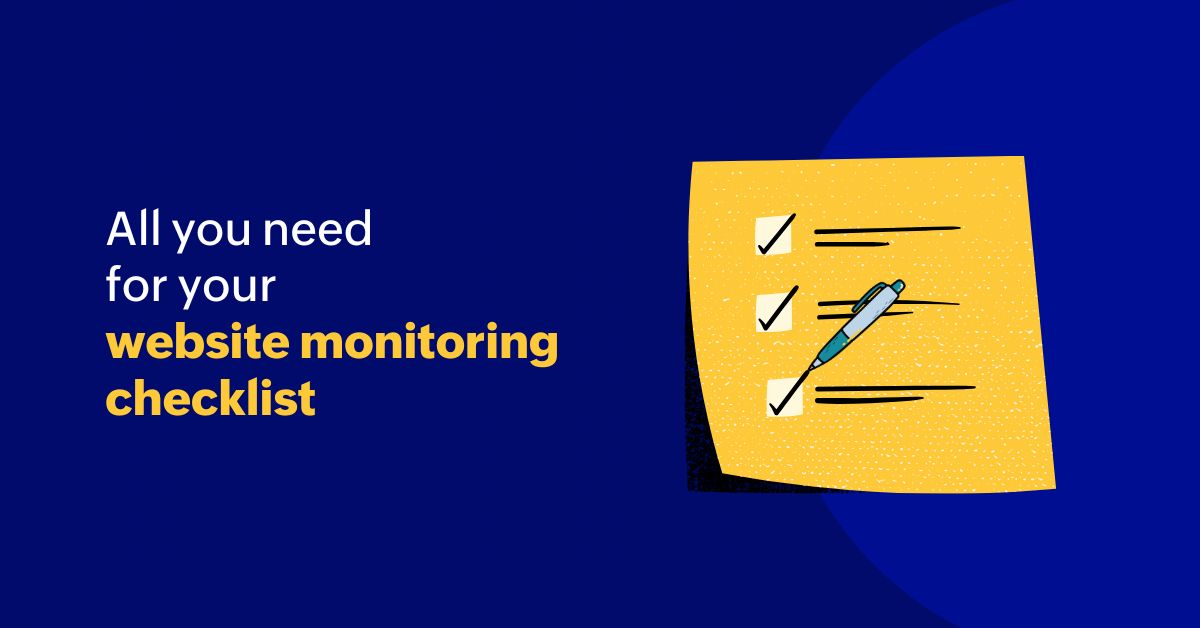Website monitoring checklist

Website monitoring can be much more effective with more specifics and details. Before diving into the specifics of monitoring, it's best to define your goals and preferences first. What is your target for implementing the monitoring? Is a better uptime all you are looking for, or do you wish to fine-tune your site's user experience?
Making a website monitoring plan that is in line with your strategy and KPIs is always preferable to a one-size-fits-all approach. For instance, you must give user-centric metrics more weight if your primary goal is to improve the site's user experience.
The importance of having a website monitoring checklist
A well-defined website monitoring checklist is similar to a structured roadmap for maintaining website health and performance. Process standardization creates transparent, repeatable monitoring protocols that enhance consistency and cooperation. Prioritizing key indicators helps you identify issues early on, plus it ensures focused action based on your specific business goals. This can ensure less downtime by assisting in better troubleshooting techniques.
Additionally, a checklist makes it easier to measure progress and emphasizes the importance of stakeholder monitoring, which enhances communication and teamwork when maintaining your website. Finally, having a thorough checklist will help you achieve improved client satisfaction and high website availability.
4 pivotal inclusions for your website monitoring checklist
Here are four main pointers for you to add to your website monitoring checklist.
1. Availability monitoring
Having around-the-clock availability is essential for any website, and putting availability on your website monitoring checklist is definitely a smart move. It is a basic check in website monitoring. Hence, your website monitoring checklist should include this aspect. The most important performance indicators to be monitored for availability checks include uptime, error rates, and response codes.
Uptime is a measure of the percentage of time your site is available for users without any outages. Higher uptime can lead to better brand reputation and user satisfaction. With Site24x7's uptime checks , ensure the availability of your site from multiple locations. In case of unavailability, Site24x7 will alert you through your preferred notification modes in real time.
Error rates are another yardstick to measure availability. High error rates indicate potential problems that need immediate attention. In order to identify the cause of the problems, Site24x7 assists you in correlating error rates with other performance-related variables. HTTP status codes and the corresponding faults (4xx or 5xx) can signal issues that require quick resolution.
2. Performance monitoring
Once you ensure the uninterrupted availability of your pages, you'll want to optimize your webpage performance . This includes all the factors that can impact the way a page loads and performs for a user, like page load time, server response time, database query latency, API performance, and more. Understanding the time it takes for various pages to load completely, including the time to first byte (TTFB), connection time, DNS time, TLS handshake time, etc., is made easier using page load time.
Slow load time can affect search engine rankings and user experience. With tools like Site24x7, quickly locate performance bottlenecks and identify the precise areas that require improvement. Site24x7's waterfall charts enable you to delve deeply into the performance of page-level resources and pinpoint the obstacles affecting them. The time it takes for servers to react to incoming requests can be measured with the aid of server response time. Performance issues and page display delays might result from a slow server response. Additionally, keep an eye on how long it takes for queries to be executed if your website depends on a database. Sluggish database queries can impact page load speed.
A slow or unreliable API can significantly affect user experience. API performance monitoring can help in finding the response times and error rates of your APIs. Site24x7 also tracks the performance of your SOAP-based web services and gRPC-based services.
3. Website security monitoring
Another important consideration in any website monitoring checklist is website security. Certain performance indicators include website integrity, blocklist checks, ensuring brand reputation, and domain or SSL/TLS expiry. Website integrity is often impacted by attacks that add malicious content or script to the webpage, commonly known as webpage defacement . Monitoring tools like Site24x7 can help you identify website defacement and resolve issues quickly. Moreover, getting blocklisted can prevent emails from reaching your customers, hinder website traffic, and damage your online reputation. With the real-time blocklist check from Site24x7, you can run continuous blocklist checks, boosting customer trust and brand reputation.
An unexpected domain or SSL/TLS certificate expiry can bring your digital presence and business to a standstill. With domain expiry monitoring and SSL/TLS certificate expiry and validity monitoring from Site24x7, you can stay updated on the expiry date of your domain and certificates.
4. Digital experience monitoring
Offering the best digital experience is no longer a luxury. It is important to track user behavior, optimize the transactions, check browser and device-based performances, drill deep to find backend issues, and get real-time updates on how your page is performing.
Site24x7's digital experience monitoring (DEM) tool helps to track user sessions and the performance of your page when a real user traverses the site with the help of real user monitoring . This DEM tool assists in identifying the issues in critical business transactions through synthetic monitoring , provides data on how your pages perform on different browsers and devices by simulating transactions, helps to trace backend issues with application performance monitoring , and much more.
A proper website monitoring checklist can help you stay focused on important metrics and be on the same page as your end users to proactively handle problems. By combining user insights with data, a carefully crafted checklist protects your bottom line and enhances the user experience of your website. In the end, this proactive strategy ensures a healthy website by preventing expensive mistakes, bugs, and design faults.